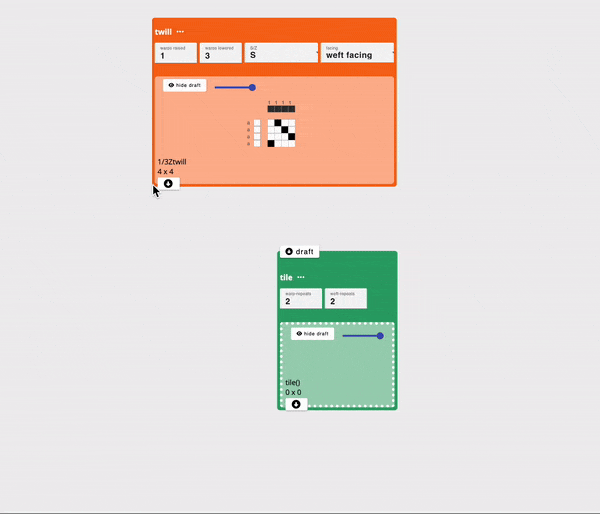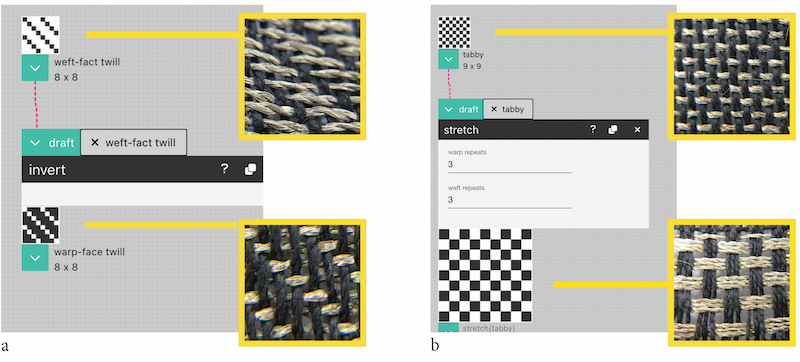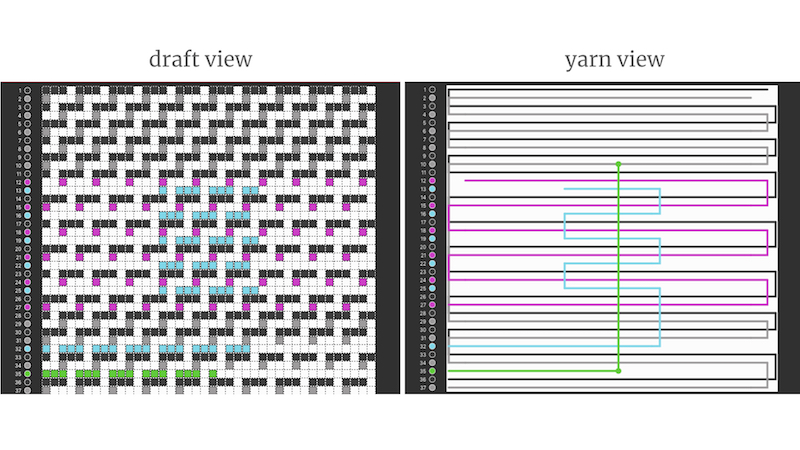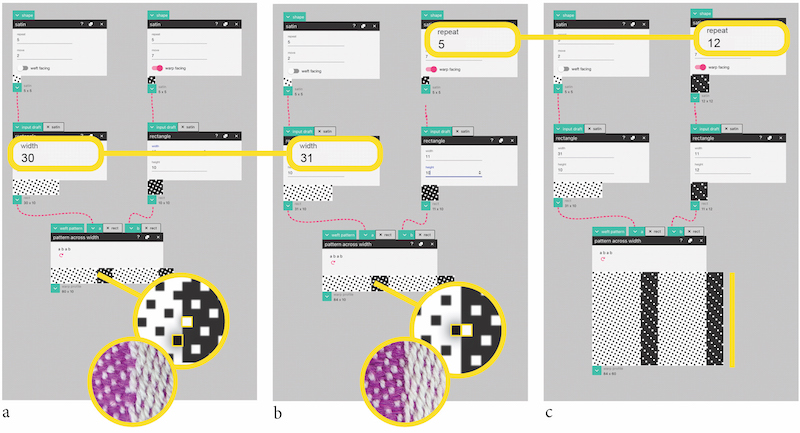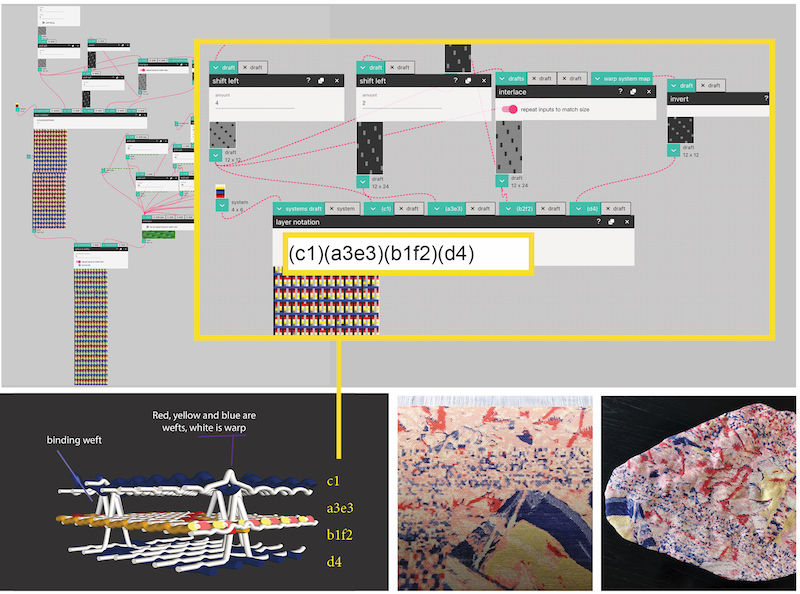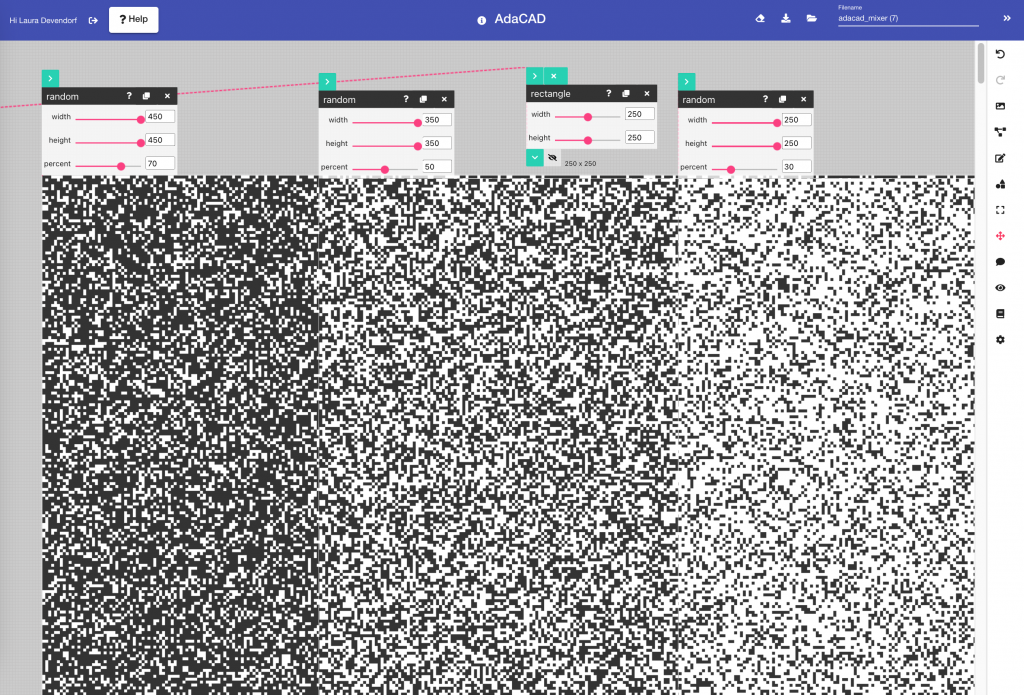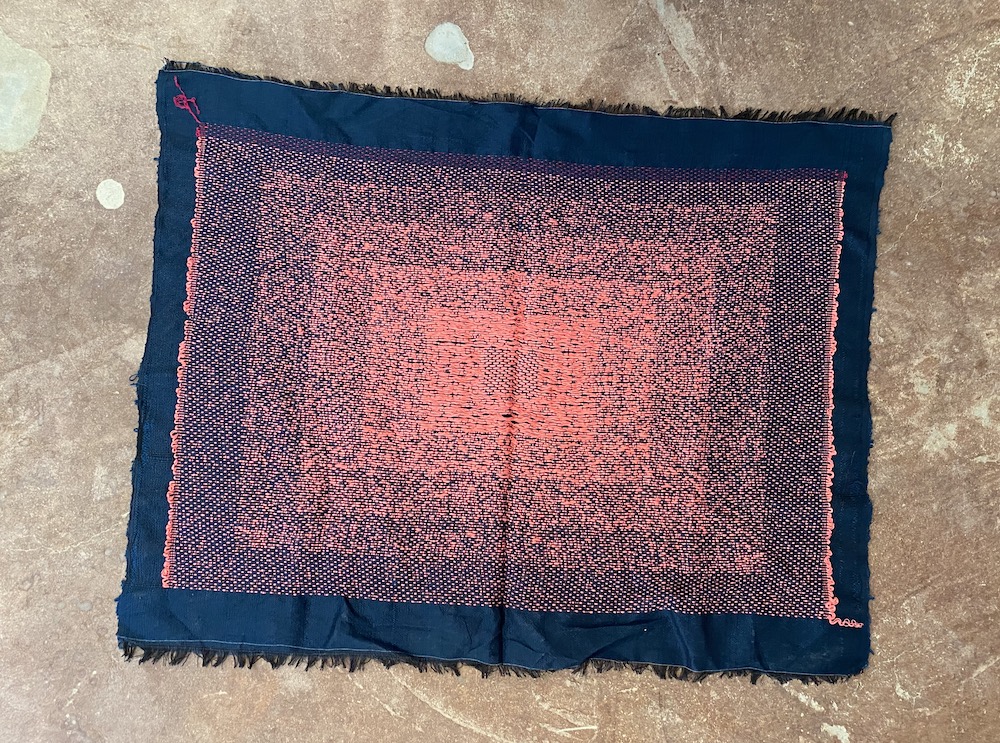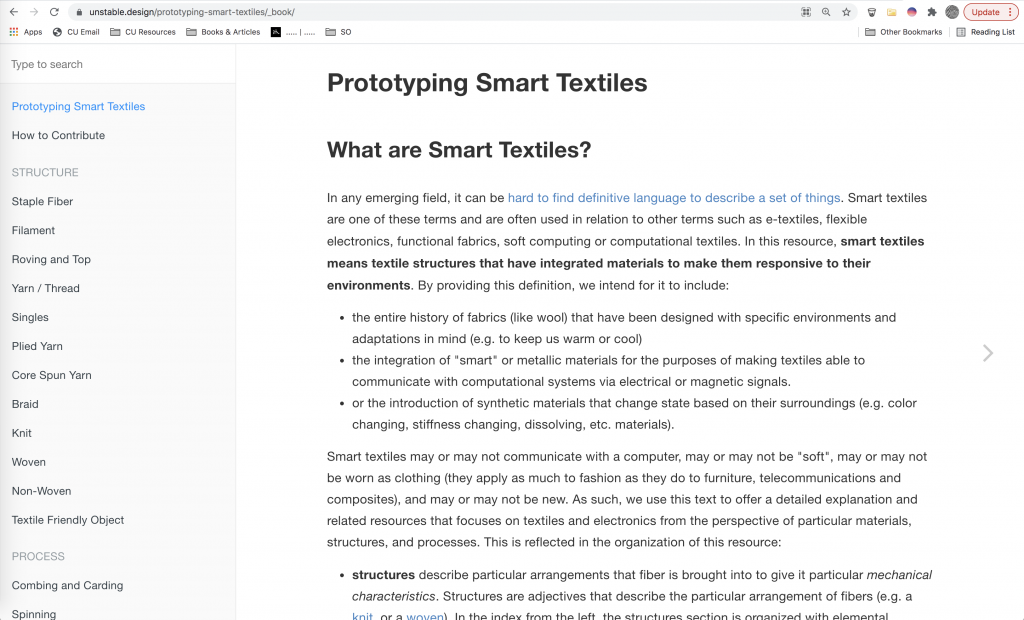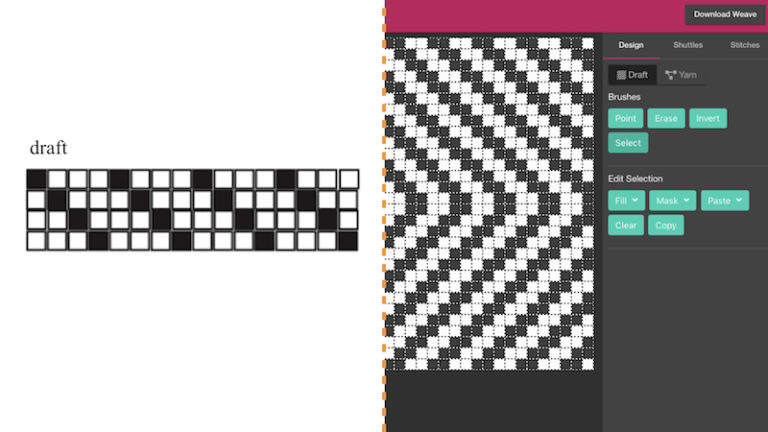Wednesdays at 9AM Mountain Standard Time
Online, Fall 2024-Spring 2025
The Experimental Weaving Talk Series returns again this Fall! This year, we have expanded the series to span from Fall 2024 to Spring 2025 and include eight speakers. We curated the 24-25 talk series around the theme of “expanding experimentation” with the goal of turning attention to the broader cultural, personal, and contextual discourses present in experimental weaving. We will hear about art, design, and research practices that engage the body, examine regional weaving histories, reflect personal narratives, utilize computational design tools, intersect with bioastronautics, and otherwise explore relationships between craft and technology.
The experimental weaving talk series began in 2022 to engage different perspectives on what “experimentation” means to weavers across art, design, and technology practices. The talks are intended for the public and are all accessible online.
All talks will be hosted via Zoom and you are invited to register for any/all of the talks at the bottom of this page
Katya Arquilla

November 13, 2024
Katya Arquilla is an Assistant Professor of Aerospace Engineering Sciences within the Bioastronautics focus area. Her work focuses on how humans interact with and adapt to complex systems in high-stress environments (e.g., long-duration space exploration missions, aircraft operating with novel controls and/or in extreme weather, and multi-agent team operations that include autonomous/robotic systems). Katya is a novice weaver, but textiles and weaving have been influential to the direction of her work, opening up the set of possibilities for garment-integrated wearable sensing that is crucial to achieving the human-centered goals of her work.
Arquilla will first discuss her research experience with experimental weaving during her time as a PhD student, then will expand the discussion to highlight research areas that can benefit from experimental weaving and the broader role of textiles in Bioastronautics.
colorado.edu/aerospace/katya-arquilla
Bhakti Ziek

December 4, 2024
Bhakti Ziek, a former college professor of weaving and textile design, is a studio artist living in New Mexico. She has co-written a book on backstrap weaving, and wrote The Woven Pixel: Designing for Jacquard and Dobby Looms Using Photoshop with Alice Schlein.
Ziek will discuss her work and why she asks “what is the best tool to accomplish this idea” before turning to her looms, which include a TC-1, two shaft looms, an inkle loom and small tapestry loom.
Ricki Dwyer

February 5, 2025
Ricki Dwyer (USA) is an artist from the San Francisco Bay Area, living in Brooklyn. His practice considers the intersections of material, industry, and the somatic. This research addresses weaving and craft in both theory and practice. Dwyer is currently a Bronx Museum AIM Fellow and teaches with the Parsons School of Design. He received his undergraduate degree in Fiber Arts from the Savannah College of Art and Design and an MFA in Studio Practice from UC Berkeley.
Dwyer will talk about how weaving embodies the idea of world’s creation, many individual threads becoming a stronger whole, and the cultural issue of reducing this process to the binary as well as how his work in abstraction is towards a somatic reckoning with our material surroundings.
Weaving X Coding

February 19, 2025
Renata Gaui and Francesca Rodriguez Sawaya (Weaving X Coding): Born in 2017, Weaving X Coding is a fruit of the collaboration between Francesca Rodriguez Sawaya and Renata Gaui, through which they explore the relationship between textiles and new technologies as a way to demystify both practices. For the last years these explorations have translated into numerous workshops, two exhibitions and collaborations with other creatives on the intertwined history of weaving and computational thinking. As artists and designers, Renata and Francesca’s personal practice have been instigating the power of emerging technologies as tools of empowerment that can challenge narratives around female identities, culture and communities.
Weaving X Coding will share how their experimentations with textiles and emerging technologies led them to uncover craftsmanship’s influence on technological advancements, and how this became a focal point of their artistic practice.
Jovencio de la Paz

March 5, 2025
Jovencio de la Paz is an artist, weaver, and educator. Their work considers the interrelated histories of weaving and computation. Collaborating with machines and computational intelligences in their practice, de la Paz creates a variety of computer softwares that algorithmically generate weave structures, capturing both intentional and errant activities of those programs as woven cloth. Their work addresses tensions between geometric abstraction and materiality, as well as the instability of woven surfaces, which can present themselves as images but ultimately betray themselves as objects. They are currently an Associate Professor and the head of the Fibers studio area at the University of Oregon in Eugene, Oregon.
In this lecture, de la Paz will explore their practice as a weaver and digital native, and present new and on-going bodies of work that utilize an adaptation of Nils Aall Baricelli’s 1956 software “BioNumeric Organisms” to generate unique weave structures and textiles. De la Paz will consider how this software and its place in the history of computation help orient criticality and optimism around emerging technology.
Kimberly English

March 21, 2025 (Friday)
Kimberly English is an artist and educator living in Appalachia. Her practice seeks to explore the nuance of interdependence – real and imagined – between land, machines, people, and the objects they create. Expanding upon her undergraduate textiles education from Savannah College of Art and Design, Kimberly English (b. 1994) earned her MFA from the University of North Carolina at Chapel Hill in Studio Art as a Carolina Digital Humanities Fellow in 2018.
English will discuss the ways in which her recent work explores the connection between the individual and the collective through historical, personal, and perceptual interrogations of textile structure.
Poppy DeltaDawn

April 2, 2025
Poppy DeltaDawn is a visual artist, weaver, and teacher making work with and about technologies of labor and culture. She has exhibited her work at LMRM (IL), Dimin (NYC), NONSTNDRD (IL), Underdonk (NYC), Below Grand (NYC), Zürcher Gallery (NYC), and Standard Space (CT), among others. Residencies and fellowships include Fondazione Arte Della Seta Lisio (Florence, IT), and a Media Arts Fellowship and Workspace Fellowship at BRIC Arts Media (NYC), and has discussed her work in Hyperallergic, Art Uncovered, and A Woman’s Thing Magazine, among others. She is an assistant Professor of Visual Art in Textiles + Fiber at the University of Kansas and was a Visiting Artist in Fiber & Material Studies at the School of the Art Institute of Chicago in 2022-23. DeltaDawn holds an MFA from Cranbrook Academy of Art and a BFA from the Maryland Institute College of Art, both in Fiber.
In her lecture, Poppy DeltaDawn will discuss the origins of weaving design and its implicit relationship to domination and ongoing colonial oppression. DeltaDawn will follow the thread from the woven basket to the digitally-woven cloth of the TC2 loom. In this conversation, she will consider the sentience of weaving, and will address her journey of thinking and becoming through weaving.
Carolina Vélez Muñiz

April 23, 2025
Carolina Vélez Muñiz (Mexico City, 1997) is an artist who weaves. She works with handmade audiovisual circuitry and textiles as means to explore the relationship between the body/space and its poetics. She has developed projects with the Jóvenes Creadores grant from the Sistema de Apoyos a la Creación in Mexico and in Chicago with the Visual Arts Fellowship from the Luminarts Foundation. She is currently working on a public art piece for Museo de Arte Carrillo Gil.
In her lecture, Carolina Vélez Muñiz will discuss weaving as a image processing technology.
Archive: 2022 Experimental Weaving Talk Series
Elizabeth Meiklejohn
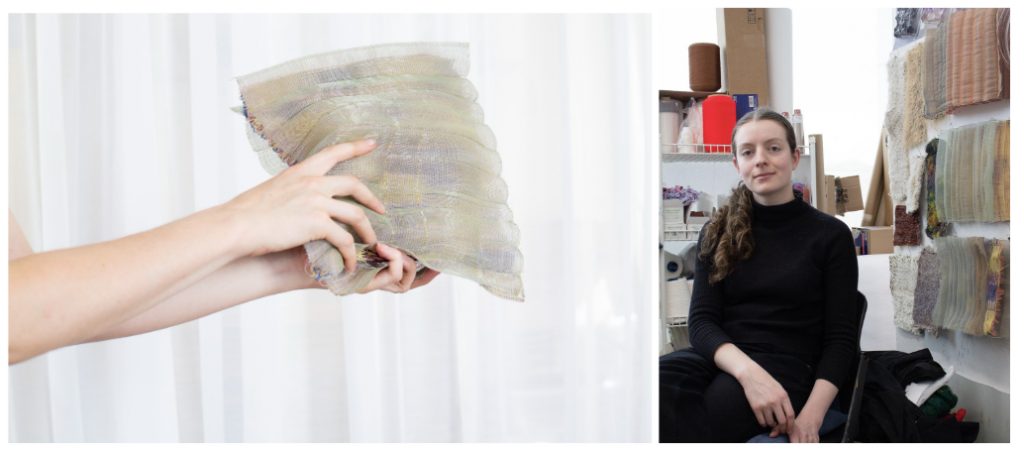
September 27, 2023
Elizabeth Meiklejohn is a textile engineer, designer and researcher focused on complex structures and experimental techniques in weaving. Her work blends digital and hands-on methods to achieve dynamic forms and capabilities in fabrics, all while investigating material origins and tendencies. Elizabeth was the 2023 Experimental Weaver-in-Residence; this talk will present her work as well as the outcomes of the residency.
Elizabeth will share her background and areas of research as a textile designer, from 3D woven structures to self-shaping fabric behavior. Her talk will cover the time she spent as Unstable Design Lab’s 2023 Experimental Weaver-in-Residence, sampling, prototyping and creating an interactive fabric while developing new systems of notation for woven textiles.
Patrice George

October 25, 2023
Patrice George recently retired from the Fashion Institute of Technology, where she was Associate Professor in the Textile Development and Marketing Department for 18 years, specializing in woven textile design, and the history of the textile industry. She participated in beta-tests and product education in the emerging field of computer-aided design in the early 1980’s, creating an early course in computer-aided woven design for the School of Visual Arts in 1984. She has been a design consultant to the interior textile industry since founding her NYC studio, Patrice George Designs, in 1979. She has also been a guest instructor at textile schools, a consultant to international handweaving projects, and a frequent presenter and workshop leader at professional textile seminars and conferences.
We’ve invited Patrice to reprise the presentation she offered at the Praxis Digital Weaving conference: From the PC to the TC: A VERY Short History of Digital Design For Woven Textiles
Patrice’s talk will trace the history of digital weaving technology, from IBM’s first software patent in 1970 for Janice Lourie’s Textile Graphics System, through the adaption of digital textile technology by industrial mills, hand loom and power loom manufacturers, textile education and artists’ explorations. The transition from slow design to advanced applications for woven textiles today will be discussed and illustrated.
Lucy Smyth

November 8, 2023
Lucy Smyth is a weaver based in Northern Ireland who works across art, design, education, and costume. Through the recurring themes of movement and contrast, Lucy interrogates the relationship between 2D and 3D to create sculptural interdisciplinary fabrics or artworks.
Driven by material and process, Lucy’s practice explores inherent behaviors to challenge and reimagine. This practical connection and the use of thinking tools such as paper folding, fabric manipulation, and sketching nurture her work to creatively evolve and achieve, achieving technically complex structures.
Lars Shimabukuro
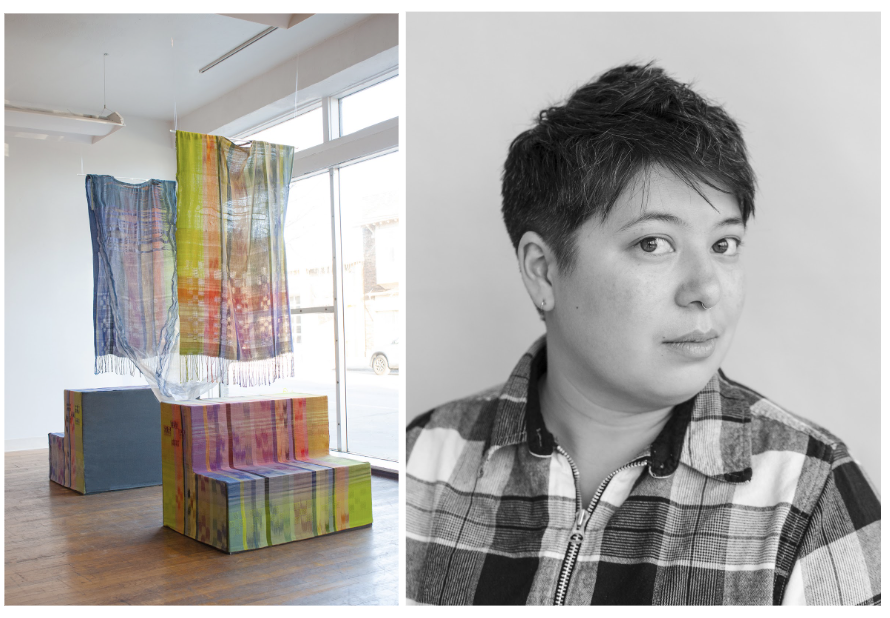
November 29, 2023
Lars Shimabukuro (b. Honolulu, Hawai’i) is a mixed and trans artist whose work expands ideas of homelands, family, and memory to include the queer landscapes that raised them. He earned a Bachelor of Arts degree in Studio Art from Yale University in 2013, an Associate Degree from Haywood Community College (NC) focusing on weaving in 2019, and completed the Core Fellowship program at the Penland School of Craft in 2023. Lars has shown nationally and internationally, and teaches weaving at craft schools.
Shimabukuro will share about their process of translating identity into weaving, and how weaving structures inspire the forms in their sculptural work. He will also share about his practice in other materials, and how those explorations are starting to incorporate textiles.
Acknowledgements
This series is hosted by Steven Frost and Laura Devendorf with the support of Etta Sandry.
Archive: 2022 Experimental Weaving Talk Series
Melanie Olde
Bio: Melanie Olde is a weaver, researcher, teacher and artist. She researches cellular structures for form, function and array to interpret these in biomimetic, moving, woven 3-dimensional cloth to advance innovative exploration. Olde works on an AVL 24 shaft CompuDobby Loom in Canberra, Australia and has also worked with mechanical and computerized jacquard systems.
Melanieolde.com
@melanie_olde
Kathryn Walters
Bio: Kathryn Walters is a PhD researcher in Textile Design at the Swedish School of Textiles. Her research investigates transformative textiles developing three-dimensional form. She explores emergent behaviour arising from the combination of material properties and textile structures, where textiles are seen as systems with responsive properties. Her process embraces the use of industrial jacquard looms as an extension of weaving as craft.
kmwalters.com/
Jessy Lu
Jessy Lu is an artist exploring textiles as a form of computation with respect to both their historical origin and technological future. With a background in R&D as a materials engineer, she has worked on exploratory applications for fabrics used in hardware technology. Her art practice focuses on exploring image processing techniques and the use of algorithms to determine pattern and color allocation. Currently, Jessy is working on a research project in Taiwan studying knots as a form of craft tradition, sculptural object, and as a framework for tactile modalities of aesthetic experience.
Alyson Ainsworth
Bio: Alyson Ainsworth is a New York City-based weaver whose work explores overcoming traditional limitations of the loom. Through the use of materials, hand manipulations, and complex weave structure, she creates weavings that combine new techniques with the familiar. She is interested in pushing the boundaries of weaving as a discipline—from both art and design perspectives—and exploring the connection of functional and aesthetic textiles in the process.
Alysonainsworth.com
@alysonainsworth
Victoria Manganiello
Bio: Victoria Manganiello considers weaving a form of communication. Her ethereal fabric pieces radiate color and light while referencing computer programming and bar codes. Manganiello is currently producing a documentary film about Women and Textiles and is an instructor at NYU and the Parsons School of the Arts in New York. Her textile-based installations combine hand-spun yarns and hand-mixed dyes with modern materials and techniques, creating conceptual hybrids that lean towards the future while employing methods from the past.
victoriamanganiello.com
@victoriamanganiello
Etta Sandry
Etta is the 2022 Experimental Weaver In Residence, this talk will present her work as well as the outcomes from the residency.
Bio: Etta Sandry is an artist, educator, and facilitator from the midwestern United States, currently based in Tiohtià:ke/Montreal. Her material-focused research is rooted in fibre and weaving and spans media through sculpture, writing, and installation. Etta completed her MFA in the Fibre & Material Practices program at Concordia University in the spring of 2021. She has exhibited her work in the United States and Canada and was the 2022 Experimental Weaver in Residence at the Unstable Design Lab in Boulder, Colorado.
ettasandry.com/
@ee_teetee_ay
